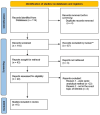The Study of Ropivacaine Pharmacokinetics in a Clinical Setting: A Critical Scoping Review from the Perspective of Analytical Methodologies
- PMID: 39769250
- PMCID: PMC11678900
- DOI: 10.3390/ijms252413487
The Study of Ropivacaine Pharmacokinetics in a Clinical Setting: A Critical Scoping Review from the Perspective of Analytical Methodologies
Abstract
Ropivacaine, a widely used regional anesthetic also used for pain management, has been increasingly used in recent years due to its increased efficacy and improved safety compared to similar anesthetics. Biomonitoring of ropivacaine and its metabolites during and after anesthesia is an essential process for ensuring therapeutic efficacy and safe usage for patients. The most useful biomonitoring tool in recent years has been liquid chromatography coupled with mass spectrometry (LC-MS/MS), which offers selectivity, sensitivity, as well as accuracy of measurements. The current manuscript summarizes and discusses the existing liquid chromatographic methods described in the literature, as well as the personal experience with developing bioanalytical and analytical methods for the quantification of ropivacaine in biological samples for clinical applications. It is focused on methodological aspects, recent advancements, challenges, and future perspectives, highlighting the importance of LC-MS/MS techniques in ropivacaine analysis.
Keywords: HPLC LC MS/MS; regional anesthesia; ropivacaine.
Conflict of interest statement
The authors declare no conflicts of interest.
Figures




Similar articles
-
LC-MS/MS assisted biomonitoring of ropivacaine and 3-OH-ropivacaine after plane block anesthesia for cardiac device implantation.Front Mol Biosci. 2023 Sep 27;10:1243103. doi: 10.3389/fmolb.2023.1243103. eCollection 2023. Front Mol Biosci. 2023. PMID: 37828919 Free PMC article.
-
Evaluation of high-performance liquid chromatography and mass spectrometry method for pharmacokinetic study of local anesthetic ropivacaine in plasma.Biomed Res. 2009 Dec;30(6):319-24. doi: 10.2220/biomedres.30.319. Biomed Res. 2009. PMID: 20051639
-
Postmortem distribution of ropivacaine and its metabolite in human body fluids and solid tissues by GC-MS/MS using standard addition method.Forensic Toxicol. 2025 Jan;43(1):163-171. doi: 10.1007/s11419-024-00695-z. Epub 2024 Sep 16. Forensic Toxicol. 2025. PMID: 39285095
-
Androgen glucuronides analysis by liquid chromatography tandem-mass spectrometry: could it raise new perspectives in the diagnostic field of hormone-dependent malignancies?J Chromatogr B Analyt Technol Biomed Life Sci. 2013 Dec 1;940:24-34. doi: 10.1016/j.jchromb.2013.09.022. Epub 2013 Sep 27. J Chromatogr B Analyt Technol Biomed Life Sci. 2013. PMID: 24140653 Review.
-
Recent bioanalytical methods for quantification of third-generation cephalosporins using HPLC and LC-MS(/MS) and their applications in pharmacokinetic studies.Biomed Chromatogr. 2014 Nov;28(11):1565-87. doi: 10.1002/bmc.3330. Epub 2014 Oct 8. Biomed Chromatogr. 2014. PMID: 25294385 Review.
References
-
- IASP Subcommittee on Taxonomy Pain terms: A list with definitions and notes on usage. Recommended by the IASP Sub-committee on Taxonomy. Pain. 1979;6:249–252. - PubMed
-
- Neal J.M. Miller’s Anesthesia. 9th ed. Elsevier; Philadelphia, PA, USA: 2020. Miller’s Anesthesia: Pharmacology of local anesthetics used in ambulatory surgery; pp. 888–920.
-
- Graff V., Gabutti L., Treglia G., Pascale M., Anselmi L., Cafarotti S., La Regina D., Mongelli F., Saporito A. Perioperative costs of local or regional anesthesia versus general anesthesia in the outpatient setting: A systematic review of recent literature. Braz. J. Anesthesiol. 2021;73:316–339. doi: 10.1016/j.bjane.2021.09.012. - DOI - PMC - PubMed
Publication types
MeSH terms
Substances
Grants and funding
LinkOut - more resources
Full Text Sources

